Other information:

March, 1998
The CRC was established under the Commonwealth Government’s Cooperative Research Centre Program in July 1993. The Cooperative Research Centre for Freshwater Ecology provides ecological understanding to improve inland waters by collaborative research, education and resource management.
contents
1. The heat is on for rare turtle
2. New directions?
3. New water quality guidelines
4. River-billabong interactions
6. Other turtle news
7. Drought having an impact on ACT streams
8. Scientists continue to survey sites in NSW rivers
Heat is on for rare turtle
The ability to choose the sex of their offspring may save this rare turtle in a warmer world.
Will it be girls this year, or boys? While the rare pig-nose turtle in Australia’s top-end has the capacity to determine the sex of its offspring, researchers are still trying to determine whether or not this relic species is manipulating this unusual trait to its advantage. Its ability to do so may be the turtle’s saving grace in the face of global climate change.
Researchers and students from the University of Canberra’s Applied Ecology Research Group (AERG) and the CRC for Freshwater Ecology have spent the last two winters camped on the croc-infested banks of the Daly River in a bid to learn more about the reproductive habits of the pig-nose turtle.
The sex of the pig-nose turtle’s offspring is determined by the temperature at which the eggs are incubated — a reproductive strategy these turtles share with many of their reptilian cousins.
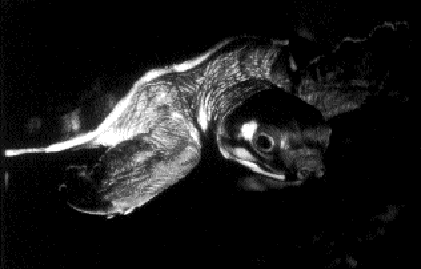
The rare pig-nose turtle, Carettochelys insculpta, found on the Daly River in the Northern Territory.
Also referred to as temperature-sex determination or TSD, this reproductive characteristic has profound influence on managing turtle populations and habitat in the wild, the project leader, Dr Arthur Georges, Director of AERG said.
Laboratory and field testing have indicated that pig-nose turtle eggs which are incubated at temperatures above 32 degrees Celsius will produce 100 percent female offspring, while those incubated at below 32 degrees will produce 100 percent male offspring. A small range of temperatures, less than one degree wide, produces both sexes.
"It certainly matters where the turtles nest as to what sex ratio comes out," Dr Georges said.
"What we’ve found is that some sand banks, depending on aspect, produce 100 percent of some sex and some sand banks produce 100 percent of another sex."
The turtles lay two clutches of eggs every second year.
"This finding is quite interesting when you consider that sex ratio is seasonally dependent," Dr Georges said.
"If the turtles nest early in the season they produce 100 percent males, if they nest late in the season they produce 100 percent females. So it may be important for them to lay two nests every second year to balance the sex ratios, rather than lay one nest a year and get 100 percent of one sex every year."
The research is designed to get a good handle on the way that temperature operates in the field to influence sex ratios so that models can be developed to predict how these animals might respond to global climate change.
While increasing temperatures may influence the turtles to produce just females, leading to the extinction of the species, these Gondwanan ancestors have been in Australia for millions of years and have felt the impact of previous climate change and survived.
"Animals respond to rapid climate change by contracting or expanding their distribution, shifting their distribution, or altering the way in which they rely on their surrounding environment," Dr Georges said.
"We should not simply be looking at the likely impact of global climate change in isolation, but rather should consider what we humans have done to limit the abilities of species to respond to global climate change."
Habitat fragmentation to meet the needs of agriculture, pastoralism and urban development has dramatically reduced the scope of species to shift distribution or to contract then re-expand their range in response to climate change. Human modifications may also simplify habitat thereby reducing the scope of species to change the way in which they draw upon resources within their environment.
"Climate change, whether human-induced or not, in combination with habitat degradation and fragmentation will be what carries many species over the brink and into extinction," Dr Georges said.
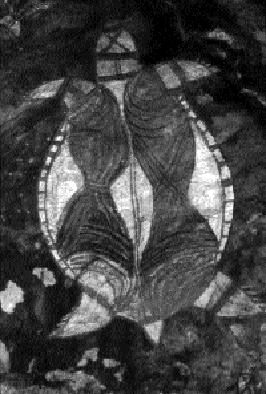
The pig-nose turtle, one of the ‘blue’ paintings at Nourlangie Rock, Kakadu National Park. The pig-nose turtle is a favourite food item of the Aboriginals in the region. It also plays a significant role in the Aborigine’s cultural history" ‘the pig-nose turtle is a sister to the green turtle. However, when the seas retreated, the pig-nose turtle decided to stay with the snapping turtle and the green turtle returned to the sea alone’.
It is within this framework that the research team is conducting the studies into the scope of pig-nosed turtles to modify offspring sex ratios in response to global climate change. The study has one more year to progress. It is part of a three-year study on reptile sex determination funded by the Australian Research Committee with the additional support of the Northern Territory Parks and Wildlife Commission.
In other turtle news
Arthur Georges has given his moniker to another freshwater turtle - Elseya georgesi, found only in the Bellinger River of north coastal New South Wales.
While naturalist John Cann discovered the turtle in 1971, it was the recent work of Dr Georges, and his colleagues and students, which established the Bellinger River turtle as a distinct species. The formal description appeared in the latest issue of Monitor, the journal of the Victorian Herpetological Society.
Collaborative work between the University of Canberra, CRC for Freshwater Ecology and the South Australian Museum, using modern molecular techniques, demonstrated that Elseya georgesi was a member of a sibling species pair. The second form hails from the Manning Drainage some160 km further south.
"This is a rarity", Dr Georges said, "Here we have two species that are so similar that they are difficult to distinguish reliably on external features".
However, a close look at the proteins and DNA structure of these animals revealed that the two turtles were quite different. The newly named turtle can be distinguished by the bright yellow streak
that runs down the sides of the neck in contrast to the steel grey upper surface of the head and neck. It has a dark brown shell and a marbled, greenish-blue underside.

CRCFE PhD student, Sean Doody digging for pig-nose turtle eggs.
New directions ?
 Peter Cullen Peter Cullen
Assessing the achievements of the CRC for Freshwater Ecology will be the aim of the Fifth Year Review to be held this August. At the same time the CRCFE is busy putting together a proposal for a new Centre to continue its important work. Discussions are underway with prospective partners, and most of the major current partners who have indicated their wish to be part of the new proposal.
In planning for the new Centre, the CRCFE has been reviewing the present and emerging ecological issues that are barriers to sustainable land and water management. What follows is a preliminary overview of these issues, presented to stimulate discussion within the water management community. We welcome feedback and ideas. There is some work being undertaken by the CRCFE and other research organisations in most of the areas presented.
Environmental allocations - how much water is required and how should it be delivered to the environment. How to measure an ecological benefit. Includes floodplain and billabong wetting.
Wetlands - inventorying, rehabilitation, understanding key processes.
Cyanobacterial blooms - minimising, managing, toxin measurement and prediction. Involves nutrient management strategies, flow management and destratification.
Algal toxins - measurement, predicting formation, toxicity, safe levels in water for various uses.
Carp - impacts and possible control strategies.
Health assessment - monitoring protocols, appropriate guidelines for ecological protection, biological assessment of river health. Includes assessment of receiving waters to identify appropriate pollutant loads from urban and rural non-point and point sources. Needed for both monitoring programs and for State of Environment assessment. Implications of climate change.
Salinity - much catchment work is already underway, but the function of salt load/pulses against ecological damage is required so that investment decisions are more soundly based. Likelihood of increasing salinity in some major catchments.
Biodiversity and nature conservation - little research yet at a systematic level for riverine communities. Some recovery plans for individual fish species. Need to understand ecology of selected species, and identify appropriate conservation strategies and reserve systems for aquatic organisms.
Pesticides - Land and Water Resources Research and Development Corporation program concluding. More understanding is required on the ecological impacts of chemicals and mixtures of chemicals on communities and food chains. Concern with possible endocrine disrupting chemicals. Need to develop restoration strategies for contaminated waterways.
Riparian area management - role of riparian zone as a buffer and a source of nutrient and energy to aquatic ecosystem.
Ecology of lowland rivers - with regard to algal growth, fish populations, environmental flow requirements, indicators of health, need for connection with floodplain, impacts of point sources and non point sources in urban and rural areas. Interaction with estuarine areas. Role in nitrogen and phosphorus transformations. Community concerns with health and amenity of lowland rivers. Determination of acceptable point and non-point loads.
Nutrient management - measurement, sourcing, biological availability, microbial cycling, effectiveness of nutrient management, importance of large occasional pulses, sediment buffering.
Artificial wetlands - designing and managing wetland/pond systems for treating urban runoff, rural runoff, agricultural wastes, sewage and so on. Issues include groundwater connections, impacts of drying cycles, insect issues and harvesting of plant material.
Organic matter and carbon - industry concerns stem from after growth in pipe systems and desirability of minimising organic matter in storages. Wider ecological issues relate to floodplain-river interactions, role in microbial cycling of nutrients from sediment.
Restoration and rehabilitation of aquatic systems - is a major emerging issue in both urban and rural areas. Measuring impacts of landcare catchment activities. Focusing activities to benefit streams. Developing appropriate ecosystems in urban streams and drains. Removal of concrete lined drains to restore more natural drainage lines.
The CRCFE will obviously not have the resources or the capacity to work on all the issues presented above. We will need collaborators if we are to tackle some of the larger issues. The CRCFE Board will decide exactly which issues will be the focus of the Centre’s activities. A number of factors will be involved in determining which issues the CRCFE will ultimately take on:
" Work already underway in the CRC and elsewhere
" Whether we have the intellectual capacity and the resources to tackle the problem effectively?
" Is there a good idea and clear hypothesis to be tested?
" What is the minimum investment to have a good chance of success?
" If the project succeeds, which partner organisations will use the results? What sort of difference will it make to the condition of our waterways and to the partner’s operations in both capital and recurrent expenditures?
New water quality guidelines focus on management problems
Ecosystem issues, rather than single indicators of stress, will be the focus of new water quality guidelines that are being developed to assist natural resource managers in identifying, prioritising and addressing the problems besieging our ailing water systems.
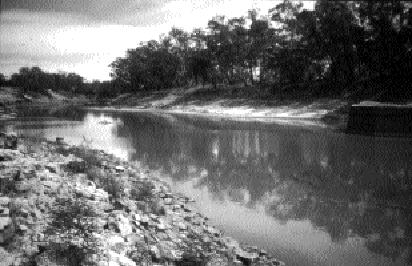  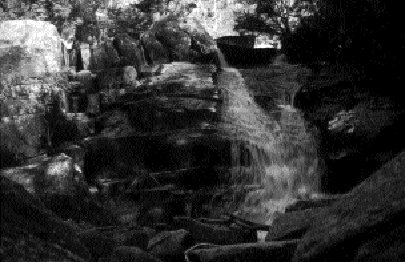
Seven specific ecosystem types will be incorporated into the new ANZECC guidelines — upland rivers, lowland rivers, lakes and reservoirs, wetlands, estuaries, coastal and marine.
 
The guidelines are being developed by the Australian and New Zealand Environment and Conservation Council (ANZECC) and the Agriculture and Resource Management Council of Australia and New Zealand (ARMCANZ).
The CRC for Freshwater Ecology has been involved in the development of these broader, more ecosystem-related guidelines that will update guidelines released in 1992.
CRC Deputy Director, Prof Barry Hart, said that previous guidelines focused too much on physical and chemical parameters with little attention to biological or ecological indicators.
While previous guidelines identified just two broad ecosystem types — marine and freshwater — the new guidelines would be more specific and focus on seven ecosystem types — upland rivers, lowland rivers, lakes and reservoirs, wetlands, estuaries, coastal and marine, Prof Hart said.
"The new guidelines will focus on the problems caused by individual physical, chemical and biological stress factors that may be adversely affecting our water resources," he said. "This is because management agencies need to tackle problems, not individual stress factors, and such problems rarely arise because of just one factor."
ANZECC has identified a number of ecosystem management issues for which guideline packages are being developed, including:
- effects in the water column due to toxicants (e.g. heavy metals, toxic organic compounds)
- effects due to toxicants associated with the sediments
- nuisance growths of aquatic plants
- maintenance of dissolved oxygen
- effects due to suspended particulate matter, salinity, temperature and pH
- effects due to changes in flow (for rivers and wetlands).
"Assessing the impact of several ‘stressors’ on Australia’s complex and variable aquatic ecosystems is not an easy job," Prof Hart said. "So we’ve adopted a ‘risk-based’ approach to determine the level of risk posed by stressors, such as chemical and nutrients, to the health of aquatic ecosystems.
"This works for each management issue by comparing key indicators, such as total phosphorus or total nitrogen concentrations, with low-risk trigger levels, or the concentrations of the key performance indicators, below which there is a low risk that adverse ecological effects will occur."
Trigger levels had been developed that were both ecosystem-specific and issue-specific, Prof Hart pointed out.
Ecosystems where the indicator concentration is lower than the trigger level, have a low risk that a problem will occur and ongoing monitoring is the most appropriate management response. However, for ecosystems where the indicator concentration is higher than the trigger level there is potential that a serious problem might occur, and more specific investigations are required.
Guideline packages have been developed for each ecosystem type and identified problems.
The packages consist of two parts:
1. Key performance indicators — these are compared with the low-risk trigger levels to make a decision on the risk of an adverse ecological effect in a particular ecosystem.
2. A protocol for investigating risks when trigger levels are exceeded.
This may include assessing the possible effect of stressors (or ecosystem-specific modifiers). If the assessment suggests a high-risk, then further site-specific investigations and perhaps ecological modelling may need to be undertaken.
Prof Hart said that the new guidelines had already been successfully tested to determine the risk of excessive blue-green algal blooms in lowland rivers.
The guidelines, which have been developed by the ANZECC Guidelines update team, will be released later this year for public review.
River-billabong interactions: the links that keep our rivers healthy
While we take the car to the supermarket for our biological supplies, rivers must rely on floods to deliver the organic material and nutrients required to keep their systems healthy.
It is the flood-assisted interaction between river channels and floodplain waterbodies that is the focus of current research being conducted by the CRC for Freshwater Ecology in collaboration with Charles Sturt University.
This work complements a suite of projects that has been undertaken to increase our understanding of the ecological needs of floodplain waterbodies, such as billabongs, particularly in terms of floods.
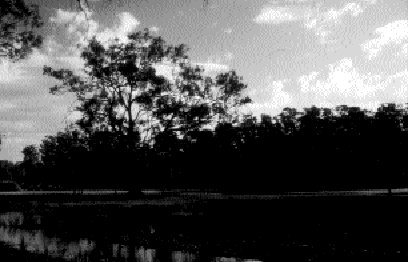
The sediment of temporary billabongs is full of dormant microscopic life, that is awakened within hours of flooding.
Work to date, conducted by the Murray-Darling Freshwater Research Centre (MDFRC), clearly indicates that billabongs are the biological storehouses of the river-floodplain system.
Leader of the CRC’s Floodplain and Wetland Ecology Program and Director of the MDFRC, Dr Terry Hillman, said that billabongs tended to be rich in plant nutrients and, because of the rapid turnover of nutrients, had the potential to support a diversity of aquatic life.
Studies conducted by Dr Russ Shiel have found that the abundance and diversity of macroinvertebrate and, particularly, microinvertebrate species are greater in billabongs than in the channels of their parent rivers. In addition, some microinvertebrates, because their food requirements are so specialised, may be restricted to a single billabong.
"This high degree of microinvertebrate endemism increases the importance of billabongs, in conservation terms," Dr Hillman said. "Who knows, one of those specialised microinvertebrates may provide a medical breakthrough in years to come."
Work in the Barmah-Millewa forests has demonstrated that temporary billabongs —those which spend some time without water — are quite different from their permanent counterparts.
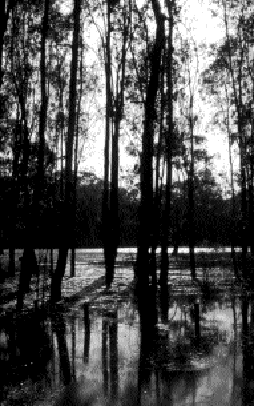 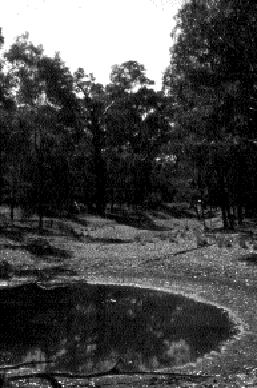
The preliminary results of flooding experiments in Barmah-Millewa Forest, and in artificial billabongs maintained near Albury-Wodonga, suggest that timing of inundation is not critical — "something’ will be cued whatever time of year flooding occurs, and regardless of duration. What is critical to the seedbank is that flooding DOES occur." - Russ Shiel
The burst of microscopic life, which follows within hours of flooding, appears to be derived from resting stages in the sediment of the temporary billabong.
Experimental work has confirmed that the wetting and drying cycle is important in maintaining the densities of microinvertebrates in billabongs. Permanent floods seem to remove the environmental ‘trigger’ necessary for awakening resting stages within the billabong ‘seed bed’. The work has also indicated that the duration of inundation may play a role in the productivity of the system. Artificial billabongs that were allowed to dry gradually before being inundated harboured increased numbers and types of microinvertebrates than a billabong which had been subjected to a rapid draw-down of water level prior to flooding.
The timing of floods, or seasonality, however, does not appear to be as important as previously thought.
"We previously thought that microscopic life would respond more vigorously to winter floods," Dr Hillman said. "But floodplains are highly variable and unpredictable systems and if these animals are going to survive over the long term, they have got to be prepared for a flood whenever it comes along."
"Our current project, River-billabong interactions during high flows, brings together the knowledge we have gained to date about the way billabongs function," Dr Hillman said. "It is the next step in finding out just how important billabongs are to the ecological functioning of our rivers."
The current project will examine the effects of flooding on seven billabongs on the Murrumbidgee River near Wagga Wagga, NSW. Three billabongs will be subjected to floods as the river height rises. The remaining four will operate as controls and will be prevented from receiving river water during floods. Flow metres will measure the direction and magnitude of flow, allowing the researchers to quantify the movement of resources in and out of these billabongs during high flows.
For the previous 10 months, the researchers have been collecting baseline data on the nutrient and hydrological status of the billabongs under low or ‘normal’ river flows. Data have also been collected on the microscopic life, macroinvertebrates and fish that inhabit the billabongs. Sampling has been conducted seasonally.
A ‘flood event’ had been scheduled to take place in the three billabongs this summer. However, the intended release from Burrinjuck Dam has been cancelled due to the drought and low storage levels.
The next opportunity to test the effects of inundation on these billabongs is likely to be following winter/spring rains.
School communities in the Wagga Wagga area will also be involved in the project, through the CRC’s education officer, Mike Copland.
Students and parents from Curranwarna Primary School, as well as the Riverina Field Study Centre, will participate in sampling the project’s billabongs for chemical data as well as macroinvertebrates.
Mike Copland said that involving schools in the study provided these communities with a chance to learn more about the billabongs in their backyard.
In addition, it had the potential of providing additional data to the project.
The river-billabongs interactions project is funded by the Land and Water Resources Research and Development Corporation (LWRRDC) and the Murray-Darling Basin Commission’s Natural Resource Management Strategy.
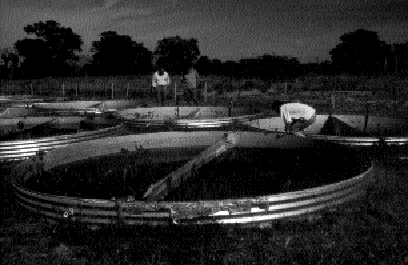
Artificial billabongs were constructed on the Murray floodplain near Albury to investigate the effects of changed hydrological patterns on macroinvertebrates, microinvertebrates and aquatic plant communities.
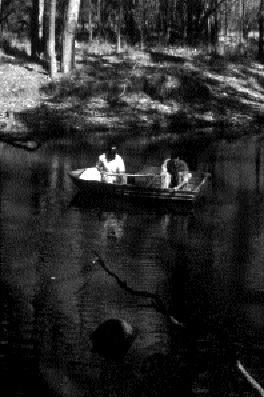
Taking water quality samples from a billabong on the Ovens River.
Drought having an impact on ACT streams
Drought is having a major impact on the health of waterways in the ACT, the results of a survey have indicated.
The survey was conducted by the CRC for Freshwater Ecology for the ACT Government as part of the First National Assessment of River Health (FNARH), which is managed by the Land and Water Resources Research and Development Corporation and Environment Australia.
More than 6000 sites across Australia are being sampled, using macroinvertebrates as biological indicators, in a bid to assess the health of the nation’s rivers.
Macroinvertebrates, or bugs, can, by their presence or absence, provide a lot of information about the condition of our waterways. While some bugs are very sensitive to pollution, others can thrive in very degraded streams.
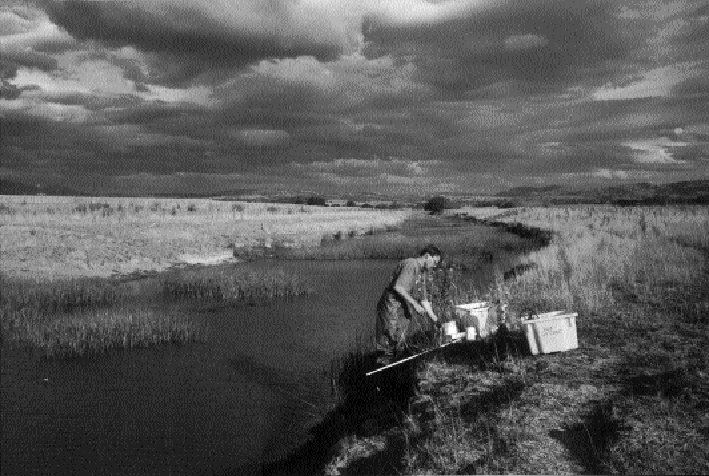
Sampling Jerrabomberra Creek as part of the survey undertaken in the ACT region for the First National Assessment of River Health (FNARH).
Last autumn, some 75 sites were sampled in the ACT region, which extends from Queanbeyan and Cooma to Yass and upstream of Burrinjuck Dam, including 10 reference, or near pristine, sites and 65 test, or potentially impaired sites.
The AusRivAS model, developed by the CRCFE, was used to analyse the data collected during the four-week sampling effort.
Project leader for the ACT component of the FNARH, Assoc Prof (Dr) Richard Norris, said that even the relatively pristine reference sites were feeling the effects of the low flows, with seven out of 10 being assessed as below reference — that is, recording a decrease in their ecological ‘health’.
A build-up of organic matter, both leaf litter and in-stream algal growth, was evident in many sites as a result of the low flows.
"Low flows have quite an impact on aquatic macroinvertebrate communities because of the associated change in water chemistry, temperature, turbidity, habitat and food availability," Dr Norris said.
The effects of land use practices were also being felt on streams in the Upper Murrumbidgee Catchment, he said.
"The autumn sampling indicates stresses such as nutrient enrichment, chemical pollutants, habitat degradation and sedimentation — which are all linked to land use activities," he said.
While mild nutrient enrichment was evident at a number of sites, its impact was difficult to separate from that of low flow.
"Invertebrate communities tend to react in similar ways to low flow and nutrient enrichment," Dr Norris said.
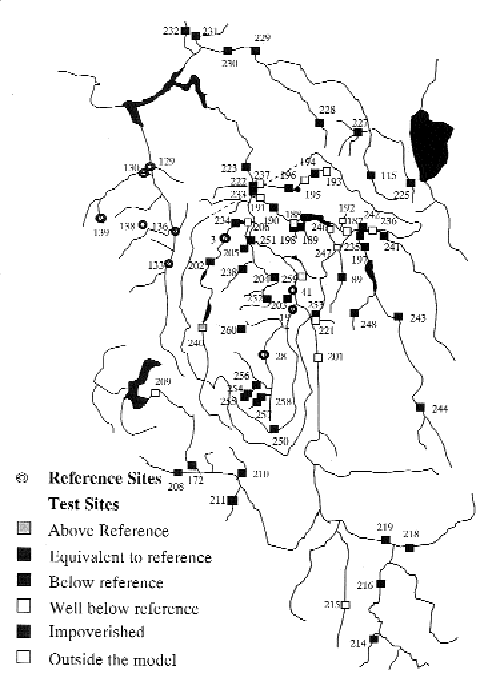
The location of test and reference sites with their AusRivAS assessments in the Upper Murrumbidgee River Catchment.
"In both cases the community will be dominated by worms and there’ll be large amounts of filamentous algae.
"River regulation is also having an impact on streams in this area. All sites downstream of dams, for example, exhibited some degree of impact."
River regulation caused a variety of impacts from deoxygenated waters to changes in flow and sediment transport — all of which were reflected in the macroinvertebrate communities present under the changed flow regimes, Dr Norris said.
In-stream habitat degradation, caused by the input of sediment, was evident at three sites, including Jerrabomberra Creek, which had been impacted by erosion on agricultural land; Murrumbateman Creek where unstable banks were causing erosion; and Ginninderra Creek which was being impacted by urban development.
Yarralumla Creek has a reasonable habitat, yet it was assessed as highly degraded due to the total absence of bugs. Standard physical-chemical water quality testing provided no indication of possible causes, however, strong petroleum odours indicated that petrol had been spilt in the area, or was leaking from a nearby service station.
"This really demonstrates the power of using bugs that measure all inputs, rather than a few chemicals that may miss important impacts, Dr Norris said.
"Overall, streams in the ACT appear to be in reasonable condition, particularly when you consider the impact that drought is having on our waterways," he said.
"The drought provided us with valuable information on the biological condition of rivers and streams under an extreme event, however, re-sampling under more usual flow conditions would increase our knowledge of the health of these rivers under a range of flow conditions."
Scientists continue to survey sites in NSW rivers
NSW Fisheries scientists and the Cooperative Research Centre for Freshwater Ecology will survey 92 sites on NSW rivers as part of ongoing work to monitor the health of the State’s river and fish resources.
Project leader, Dr John Harris said that the survey was a continuation of the work that began three years ago with the NSW Rivers Survey which identified many issues affecting freshwater fish and rivers, and threw new light on environmental degradation of the Murray River system.
Twelve new sites were being added to the 80 sites monitored during the original study, Dr Harris said.
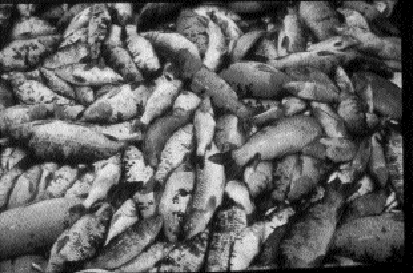
The NSW Rivers Survey report, released last year, identified an average of one carp for every square metre of river surface area.
Sampling methods had also been streamlined for the new survey and all fish sampling was now being done with boat-mounted electrofishers, including a new light weight boat for small stream habitats.
Staff from NSW Fisheries’ Office of Conservation at the Fisheries Research Institute at Cronulla and the Narrandera Fisheries Centre will conduct the summer survey.
For a copy of the NSW Rivers Survey report or summary brochure, contact Dr John Harris on (02) 9527 8411.
CONTACTS
Director:
Prof Peter Cullen
University of Canberra
PO Box 1
BELCONNEN ACT 2616
Phone: (06) 201 5168
Fax: (06) 201 5038
Dr Terry Hillman
Deputy Director/ Program Leader
Floodplain and Wetland Ecology
Murray-Darling Freshwater
Research Centre
PO Box 921
ALBURY NSW 2640
Ph: 060 58 2312
Fax: 060 431 626
Email:
terryh@mdfrc.canberra.edu.au
Professor Barry Hart
Deputy Director/Program Leader
Water Quality and
Ecological Assessment
Water Studies Centre
Monash University
PO Box 197
CAULFIELD EAST VIC 3145
Ph: 03 9903 2326
Fax: 03 9571 3646
Email: barry.hart@sci.monash.edu.au
Articles in Watershed may be reproduced without prior permission provided the article is reproduced in full and the source is acknowledged.
Editor: Karen Markwort
Communication Manager
CRC for Freshwater Ecology
University of Canberra
PO Box 1
BELCONNEN ACT 2616
|